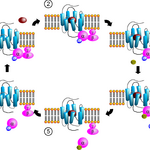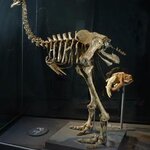Genetics & Molecular Biology

Labyrinthulomycetes, single-celled marine decomposers that eat non-living plant, algal, and animal matter, are ubiquitous and abundant, particularly on dead vegetation and in salt marshes and mangrove swamps.
Although most labyrinthulomycetes species are not pathogens, the organisms responsible for eelgrass wasting disease and QPX disease in hard clams are part of this group.
In addition, genomic information might suggest ways to exploit labyrinthulomycetes in novel biotechnological applications. Labyrinthulomycetes produce a wide array of enzymes and some species can degrade crude oil…

Over 60 percent of the nearly 5,000 genome projects reported in the Genomes OnLine Database involve microbes. It's no surprise. Microbes are important in everything from bioenergy to agriculture and medicine and are involved in Earth’s biogeochemical cycles.
A lot could be done with microbial genomics, says DOE JGI Genome Biology head Nikos Kyrpides writing in Nature Biotechnology, if researchers go beyond the present anthropocentric focus and institute shared standards for genomic data collection and analysis.
According to Kyrpides, nearly 1,000 microbial genomes have…

Georgia State University researchers are manipulating individual atoms in DNA and forming unique molecules in hopes of understanding the mechanisms of DNA replication and transcription, and perhaps leading to new treatments for diseases.
Chemistry and chemical biology Professor Zhen Huang and his lab were able, for the first time, to manipulate groups of molecules called methyl and phosphate groups in DNA that have been altered to contain selenium in order to bring them close enough together to form hydrogen bonds.
Such interactions may reduce the energy needed for a process called DNA duplex…

In the 150 years since the publication of Charles Darwin's 'Origin of Species', despite consistent patterns of biodiversity identified over space, time, organism type and geographical region, there still remain two views of the process of 'speciation', the evolutionary process by which new biological species arise.
The first requires a physical barrier; a glacier, mountain or body of water that separates organisms, enabling groups to diverge until they become separate species. In the second scenario, an environment favors specific characteristics within a species, which…

Scientists in Atlantic Canada say they have found a gene that may play a role in skin aging. Researchers were investigating the genetic cause of a rare disorder known as cutis laxa type 2 (CL2), which causes skin on the hands, feet and face to be loose and older looking, as well as growth and developmental delays including effects on the brain. In the process, researchers found some interesting correlations with the synthesis of proline, a chemical associated with skin and joint health. Several maritime Canadian families with CL2 were identified by clinicians at the IWK Health Centre’s…

A single evolutionary event appears to explain the short, curved legs that characterize all of today's dachshunds, corgis, basset hounds and at least 16 other breeds of dogs.
The research team led by the National Human Genome Research Institute (NHGRI) scientist Elaine Ostrander, Ph.D., examined DNA samples from 835 dogs, including 95 with short legs. Their survey of more than 40,000 markers of DNA variation uncovered a genetic signature exclusive to short-legged breeds. Through follow-up DNA sequencing and computational analyses, the researchers determined the dogs' disproportionately short…

A gene called Chd1 has been identified in a Nature study as crucial for embryonic stem cell pluripotency - the ability to differentiate into any type of cell. Chd1 seems to act by keeping the genetic material open and there poised to express any gene. Chd1 is also shown to be fundamental when reactivating differentiated tissue cells in order to create new stem cells.
The discovery has implications, not only for a better understanding of stem cells unique characteristics, but also for the process of obtaining them from tissue-specific cells avoiding all the problems associated with…

I'm a G-protein coupled receptor (GPCR) fan, and all of you should be too. Most drugs, from pot to tylenol, act on G-protein Coupled Receptors. The pharmaceutical industry would be helpless without them.
For a quick primer on GPCRs, you can try to decipher this picture:
Or just check out Wikipedia.
Anyway, GPCRs, in response to hormones or drugs, activate a three-component G-protein, which in turn switches on a signaling pathway. The key is that all three-part G-proteins are basically the same - they need each of the three components, and those components hang out at the plasma membrane of…

Scientists have discovered the gene behind Recessive Omodysplasia, a rare skeletal disease characterised by short-limbed dwarfism and craniofacial anomalies. The work, just published in the American Journal of Human Genetics, reports the identification on chromosome 13 of a gene - GPC6 – that is shown to be crucial for normal bone development.
The research will allow a better comprehension, as well as prevention, of the disease by permitting the screening of potential mutation carriers in pregnancy but most importantly will also help to understand better bone development and its molecular…

Welcome back, Moa. Scientists say they have performed the first DNA-based reconstruction of the giant extinct moa bird using prehistoric feathers recovered from caves and rock shelters in New Zealand.
The researchers from the University of Adelaide and Landcare Research in New Zealand have identified four different moa species after retrieving ancient DNA from moa feathers believed to be at least 2500 years old.
The giant birds, measuring up to 2.5 meters and weighing 250 kilograms, were the dominant animals in New Zealand’s pre-human environment but were quickly exterminated after the…